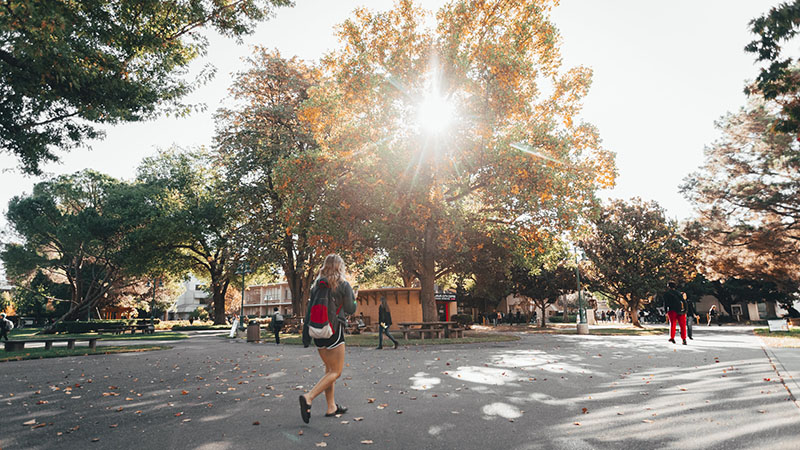 Far fewer students, faculty and staff will be on campus for the Fall 2020 semester, according to plans announced by Sacramento State that stress safety in the face of the COVID-19 pandemic. (Sacramento State/Hrach Avetisyan)
Far fewer students, faculty and staff will be on campus for the Fall 2020 semester, according to plans announced by Sacramento State that stress safety in the face of the COVID-19 pandemic. (Sacramento State/Hrach Avetisyan)
By Cynthia Hubert
Sacramento State has established a detailed plan for modified teaching, learning, living and working on campus for the Fall 2020 semester in response to the COVID-19 pandemic.
The CSU Chancellor’s Office has approved the University’s strategies for curbing spread of the virus as a limited number of students, faculty and staff prepare to return to campus, many for the first time in months. The plan is consistent with state and Sacramento County public health guidelines, officials said.
The University will remain vigilant, President Robert S. Nelsen said: “The pandemic is a dynamic situation, and we will continue to evolve as the situation changes.”
Although most academic courses will be delivered virtually when instruction begins Monday, Aug. 31, fewer than 6% of classes will occur in person. Classrooms will have fewer seats, and students and faculty will be required to wear face coverings and practice physical distancing, among other measures that public health officials say are necessary to help prevent transmission of the novel coronavirus, which causes the potentially deadly COVID-19 illness.
Similar rigorous standards will be applied to a limited number of people who will live in campus housing, eat at campus dining establishments and take part in athletic activities, according to the University’s plan.
The University will install signs and markers to promote physical distancing of six feet, and will require everyone to wear face coverings while in public areas on campus where such separation may not be possible. The campus also will increase sanitation and cleaning efforts.
Sac State will encourage people who are particularly vulnerable to the virus to continue to work remotely. The University will urge anyone who feels ill or has been exposed to the virus to isolate themselves and contact their medical provider.
The University worked with each of its colleges to determine which courses cannot be effectively conducted in a strictly online format because of equipment, space and accreditation requirements. These classes include Film Studies, Theater, Chemistry, Engineering, Nursing and Biology. A total of no more than 3,000 students will be enrolled in the classes, and all will be required to comply with strict health and safety requirements.
Though the measures may be uncomfortable for some at first, they are necessary to protect the campus community, Nelsen said.
“The health and safety of our students, staff, and faculty is our top priority,” Nelsen said. “We worked closely with the faculty, department chairs, and deans to identify the absolute minimum number of courses that will be taught in person on campus this fall. Each course, we believe, cannot be taught virtually if our students are to achieve the learning objectives, skills, and knowledge that they will need to graduate with an excellent education."
If changing conditions require in-person classes to be stopped, they could return to online only, administrators said. Faculty already are making plans for a possible pivot.
Courses that begin in person “would likely have to be switched to a virtual format during the term if a serious second wave of the pandemic occurs,” CSU Chancellor Timothy P. White said in May. Planning for a switch to virtual learning “preserves as many options for as many students as possible.”
Residence halls at Sac State will operate at 50% capacity this fall, with most rooms limited to one person. University Housing Services will train residence hall staff on various public health protection measures and will install hand sanitizers, acrylic barriers, and signs to guide students and others using the buildings.
Two dining venues will serve resident students: the Servery at the Dining Commons, and the Courtyard Market. Guests will be asked to queue at least six feet from the nearest person. Cashiers and guests will be separated by barriers, and restaurants will accept meal cards and credit cards only.
Students who wish to use lounges or other common spaces will need to do so based on a schedule that will limit occupancy at any given time. They will be required to check out a key to access the spaces, and cleaning supplies will be provided for their use on the premises.
Athletics also may return to campus in the fall, but participation would be limited and measures taken to keep the virus at bay. Sac State is awaiting guidance from the state before addressing the future of its sports programs, Nelsen said.
Discussions are ongoing among Sac State administrators, state officials and the Chancellor’s Office about future athletic activities, including practices and games.
Across campus, custodial and facilities personnel who are considered essential staff have been practicing COVID-19 safety and maintenance measures since most campus operations went virtual in March, and they will continue to do so into the fall. They are providing increased sanitation of public areas such as lobbies and common restrooms, boosting disinfection of door handles, elevators and other “high-touch” areas, and adjusting building systems to improve circulation and draw in more fresh air.
